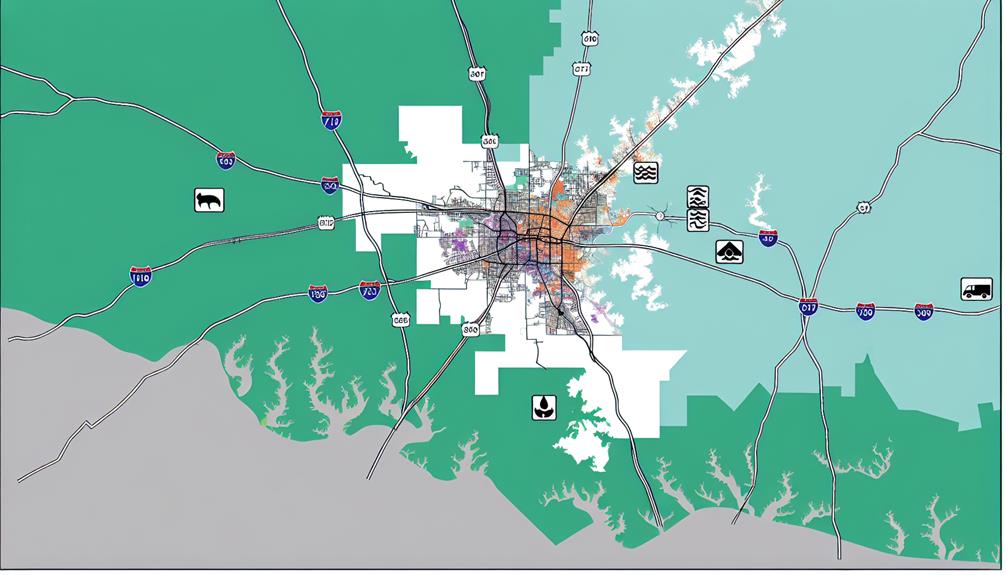Ever wondered how Houston's transportation system holds up so well during disasters?
The key is smart planning, teamwork, and serious funding that keep the city's roads open and recovery efforts swift.
Let's dive into how these factors make Houston's transportation network tough in the face of adversity.
Proactive Funding Initiatives
Fueled by the Department of Transportation, Harris County and H-GAC have secured over $10 million to boost climate-resilient transportation projects via the PROTECT program. This initiative aims to strengthen infrastructure against extreme weather impacts.
Harris County is actively working on a master plan to evaluate drainage infrastructure capacity, a crucial step in fortifying resilience against flooding and other climate challenges. Similarly, H-GAC's Resilience Improvement Plan focuses on enhancing transportation systems to align with the PROTECT program's goals.
These funding efforts play a key role in enhancing the region's ability to withstand and recover from harsh weather conditions swiftly. Houston is taking proactive steps to safeguard its transportation networks and drainage systems against potential disruptions. By making strategic investments and engaging in detailed planning, the area is fortifying itself against the escalating threats of climate change, showcasing a model for sustainable urban development that prioritizes resilience.
Strategic Planning for Resilience
Improving Houston's transportation infrastructure resilience is all about smart planning that brings together different ways to get around, especially when disasters strike. This means creating solid plans to check drainage systems and boost the ability of transportation systems to bounce back after tough times. These plans are key to standing strong against the challenges of climate change.
Programs like PROTECT are a big help by putting money into projects that can handle the changing climate. Working together with important groups like Harris County and H-GAC is vital for making sure our infrastructure can handle extreme weather.
In Houston, the focus is on protecting crucial transportation routes, like the Houston Ship Channel, from powerful storms. Projects like the coastal barrier plan, known as the Ike Dike, are part of the plan to shield these important transportation links from the impact of severe weather events.
Department of Transportation Support

The Department of Transportation's recent allocation of over $10 million is a game-changer for Harris County and H-GAC when it comes to climate-resilient transportation projects in Houston. This support from the DOT, part of the PROTECT program under the Infrastructure Law, is a vital boost for improving infrastructure resilience in the Houston area.
Harris County is taking full advantage of this funding to craft a detailed master plan that evaluates drainage infrastructure, with the goal of effectively reducing flood risks. Meanwhile, H-GAC is zeroing in on developing a customized Resilience Improvement Plan to bolster transportation systems against the impacts of climate change.
This investment is a key step in strengthening Houston's transportation infrastructure, making it more resilient to disasters like flooding. By strategically distributing these resources, the DOT is making a significant contribution to the creation of climate-resilient transportation projects that will protect Houston's infrastructure from future challenges.
Climate-Resilient Projects
I've been entrusted with overseeing climate-resilient projects in Houston, focusing on beefing up infrastructure to tackle future climate challenges. Harris County and the Houston-Galveston Area Council (H-GAC) have scored a hefty $10 million from the Department of Transportation (DOT) for projects that can stand up to climate impacts.
This funding is part of the PROTECT program under the Infrastructure Law and Inflation Reduction Act, aiming to boost infrastructure resilience against climate change effects. Harris County is currently working on a master plan to check the capacity of drainage infrastructure, while H-GAC is putting together a Resilience Improvement Plan for transportation systems. These efforts aim to strengthen transportation infrastructure against extreme weather and support sustainable urban growth.
Harris County's Infrastructure Investments

Harris County is really stepping up its game when it comes to making sure our infrastructure can handle the effects of climate change. They've scored big with more than $10 million from the DOT to pump into projects that will make our transportation systems tough against whatever Mother Nature throws our way.
Harris County is all about boosting its drainage system to tackle flood risks head-on, showing they mean business in keeping us safe. And let's not forget the H-GAC crew, who are putting together a plan to beef up our transportation systems to handle climate change impacts like a boss.
These moves show that Harris County and H-GAC are serious about making sure our infrastructure can take a hit and bounce back. It's all about laying down a solid foundation for a transportation network that's strong and ready for whatever comes our way.
PROTECT Program Benefits
The goals of the PROTECT program cover essential areas like disaster readiness strategies, protecting infrastructure, and engaging with the community. These aspects play a crucial role in strengthening transportation systems against severe weather and natural calamities.
Disaster Preparedness Strategies
Houston's PROTECT program is making waves by focusing on climate-resilient transportation projects and securing significant funding to boost disaster preparedness efforts in the area. The program is actively investing in flood mitigation initiatives and improving infrastructure to better withstand extreme weather conditions.
Harris County is currently assessing its infrastructure capabilities to craft a comprehensive disaster preparedness strategy, while the Houston-Galveston Area Council is hard at work developing a Resilience Improvement Plan for the transportation systems in the region. These investments are vital for ensuring that roads and bridges remain functional during disasters, ultimately supporting the local economy.
Moreover, the Greater Houston Partnership's advocacy for disaster recovery funding underscores the community's dedication to fortifying disaster preparedness measures and ensuring the resilience of Houston's transportation infrastructure.
Infrastructure Safeguard Measures
Investing in climate-resilient transportation projects through the PROTECT program is crucial for strengthening infrastructure against severe weather conditions and disasters in Houston. With funding exceeding $10 million from the DOT, a comprehensive master plan will be developed to evaluate the drainage infrastructure capacity in Harris County.
Additionally, H-GAC will create a Resilience Improvement Plan focusing on enhancing transportation systems to withstand challenges. These initiatives aim to boost the resilience of transportation networks, ensuring the smooth operation of roads, bridges, and overall infrastructure during emergencies.
Community Engagement Initiatives
Getting involved with local communities through the PROTECT program is a game-changer when it comes to tackling transportation infrastructure issues and boosting disaster resilience. This program has already poured in over $10 million to fund projects geared towards climate-resilient transportation in Harris County and the Houston-Galveston Area.
Harris County is rolling out a comprehensive plan to evaluate the capacity of drainage infrastructure, while the Houston-Galveston Area Council (H-GAC) is deep into crafting a Resilience Improvement Plan for their transportation systems with backing from the PROTECT program. These moves are crucial in beefing up infrastructure to withstand the impacts of climate change and amping up preparedness and response efforts during disasters in the region.
Comprehensive Drainage Infrastructure Plans
When it comes to planning out Houston's drainage systems, we really need to focus on making sure they can handle floods effectively and sustainably. These two key factors will seriously boost the city's ability to bounce back after heavy rains or storms.
Effective Flood Management
When it comes to improving flood management in Houston, one of the key steps is to enhance the city's drainage infrastructure to bolster transportation resilience during disasters. Here are some practical tips to make this happen:
- Assess Current Capacity: Start by evaluating how well the existing drainage infrastructure can handle flood events.
- Create Resilience Strategies: Develop detailed plans that specifically focus on safeguarding transportation systems to reduce the impact of flooding.
- Utilize Funding Resources: Make use of the Flood Infrastructure Fund in Texas to support the implementation of drainage projects.
- Coordinate Federal and Local Initiatives: Work together at both federal and local levels to improve flood management through infrastructure enhancements.
- Build Disaster Resilience: By implementing comprehensive drainage plans, not only can you mitigate floods but also strengthen Houston's overall transportation infrastructure resilience during disasters.
Sustainable Water Systems
Investing in sustainable water systems is crucial for strengthening Houston's transportation infrastructure against flooding disasters. Effective water management plays a key role in reducing flood risks and improving drainage infrastructure performance during extreme weather events.
Harris County's detailed plan to evaluate drainage infrastructure capacity aims to address weaknesses and enhance resilience to disasters. The Resilience Improvement Plan by H-GAC outlines strategies to incorporate sustainable water management into Houston's transportation networks.
Comprehensive drainage infrastructure plans are vital for managing flood impacts and ensuring the durability of transportation systems. By adopting a thorough approach to sustainable water systems, Houston can better prepare for and withstand the challenges posed by flooding disasters.
Resilience Improvement Strategies

Houston's transportation infrastructure is getting a resilience boost thanks to a joint effort by Harris County and the Houston-Galveston Area Council (H-GAC). They're crafting a solid plan to make sure our roads and systems can weather any storm. Here are five key moves in the works to toughen up our infrastructure:
- Harris County is on it with a master plan to check our drainage systems and make them more resilient.
- The H-GAC is cooking up a special plan to beef up our transportation systems' resilience.
- The DOT's PROTECT program is throwing over $10 million into the ring to help our infrastructure stand strong against climate change hits.
- The focus is all about building projects that can handle the wildest weather and disasters.
- These steps are all about keeping Houston moving, even when things get rough, to protect our community's safety and economy.
Enhancing Transportation System Functionality
Improving Houston's transportation system involves making sure all kinds of transportation options work well together to keep people moving smoothly, especially during emergencies. Houston has a strong transportation network that includes roads, trains, water routes, and air travel. This mix helps with evacuations and getting supplies to places quickly when disasters like hurricanes hit, making sure the city can handle sudden changes in population. Having a good variety of transportation choices is key for keeping things running smoothly during crises.
During Hurricane Harvey, looking at Twitter data on maps showed that neighborhoods with different ways to get around handled the population movements better. Studies done after the hurricane stressed how important it's to have a mix of transportation options to make cities more resilient and better at handling disasters. By using a mix of transportation methods, Houston can make its overall transportation system stronger and be more ready for future emergencies.
Disaster Recovery Preparedness

Houston is really stepping up its game when it comes to being ready for disasters, especially in keeping its transportation system strong. Here's how they're doing it:
- Smooth Traffic Moves: After a disaster hits, they've got plans to quickly fix roads and keep traffic flowing well.
- Big Bucks for Floods: Harris County's $2.5 billion bond program is a huge help in making sure floods don't mess things up too much.
- Teamwork is Key: The feds, the state, and the locals all join forces to plan and handle disasters together.
- Cash for Flood Fixes: Texas set up a Flood Infrastructure Fund to give Houston extra money to prep for future disasters.
- Getting Ahead of Trouble: By being proactive and investing in safety measures, Houston can see disasters coming and take action before things get really bad.
Houston's got a handle on disaster readiness, and it shows in the way they keep their transportation system running smoothly, even when things get tough.
Safety of Transportation Networks
When it comes to keeping Houston's transportation networks safe, having backup plans in place is key. By having multiple routes available, we can make sure that disruptions don't bring everything to a standstill.
Being ready for emergencies means we need to plan ahead and practice how we'd respond to any issues that pop up in our transportation system.
Regularly looking after our infrastructure is crucial to keeping everything running smoothly and avoiding any potential safety risks.
Network Redundancy for Safety
Having multiple ways to get around in Houston is a game-changer, especially when things get tricky. Here's how having backup options for transportation keeps things moving smoothly:
- More Paths to Take: With different routes available, unexpected road closures don't have to throw you off track.
- Mixing It Up: Whether you hop on a bus, catch a train, or jump on a ferry, having various options means you're never stuck.
- Safety Net: Redundant networks make sure our transportation systems are sturdy and secure, keeping everyone safer.
- Dealing with Disruptions: When emergencies crop up, alternate routes and modes help cut down on delays and keep things running.
- Always Open: Even in tough times, redundancy ensures that critical services stay within reach, no matter what.
Emergency Response Preparedness
Houston's transportation infrastructure is well-prepared for emergencies, thanks to detailed plans for quick responses. When disasters strike, road closures, detours, and real-time traffic management ensure a rapid reaction to keep everyone safe.
Collaboration among emergency responders, transportation agencies, and local authorities is vital for keeping the transportation networks running smoothly and securely. Regular drills and clear communication guidelines further enhance readiness.
Infrastructure Maintenance Practices
Maintaining Houston's transportation networks is crucial for keeping everyone safe and moving smoothly. Regular check-ups and fixing things quickly are key to making sure our roads and bridges stay strong, especially when facing possible disasters.
Let's take a look at how Houston takes care of its infrastructure:
- Following maintenance schedules to stop things from falling apart.
- Acting fast to repair things and avoid causing big traffic jams.
- Adding safety signs, lights, and clear road markings for better visibility.
- Doing regular checks to catch problems early on.
- Keeping our roads and bridges in top shape to be ready for emergencies.
All these steps work together to make sure Houston's transportation system stays tough and reliable, no matter what comes our way.
Frequently Asked Questions
Is Houston a Resilient City?
Houston really knows how to bounce back. The city has put a lot of thought and money into improving its transportation systems to be ready for disasters. Projects like the Ike Dike and teaming up with different groups have made Houston stronger when facing tough times.
What Is the Natural Disaster Risk in Houston?
Have you ever wondered about the natural disaster risks in Houston? Being located along the Gulf Coast, Houston is prone to hurricanes, floods, and severe storms due to its flat terrain and proximity to the Gulf of Mexico. This highlights the urgent need for strong and resilient infrastructure to withstand these challenges effectively.
Is Houston Vulnerable to Hurricanes?
Living in Houston along the Gulf Coast puts you at risk of hurricanes and severe weather. When a storm hits, you might encounter road closures, heavy traffic, and the need to evacuate. The city's drainage systems and transportation networks can struggle to handle the storm surges and intense rainfall. It's crucial to stay prepared and informed to navigate these challenges effectively.
What Is the East Houston Resilience Plan?
The East Houston Resilience Plan is all about beefing up the area's transportation setup to handle disasters better. This includes beefing up roads, bridges, and public transit to take on natural threats. By using smart design approaches that can weather the storm, the plan ensures everything keeps running smoothly when things get tough.
